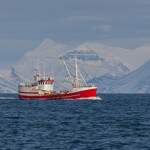Slinky pots revolutionize Alaska’s blackcod fishery

When Shawn McManus, skipper of the F/V Vansee, left Seattle in the spring of 2020 to longline for blackcod in Alaska, the outlook was not good. The burgeoning pandemic had injected uncertainty into a fishery that was already struggling with flagging prices and crippling whale depredation.
On the grounds, McManus and his colleagues estimated half their catch, sometimes more, was being snatched off hooks by orcas and sperm whales. Fishermen with bigger boats and more powerful hydraulics had long ago switched to whale-proof rigid pots, but they were not an option for smaller operations like the Vansee, a 107-year-old halibut schooner with limited deck space.
Veteran fisherman Buck Laukitis was among those who had switched to rigid pots. He looked on in dismay as depredation threatened not just individual boats but the fishery at large.
“We needed 75 or 80 percent of the fishing done by pots, or we were going to kill the resource off by feeding whales,” Laukitis said.
In a last ditch attempt to save his season, McManus threw in 50 so-called slinky pots before he left Seattle’s Fishermen’s Terminal. To him, it was a new and virtually unknown product, a lightweight collapsible pot that would fold flat and stack on deck, giving boats like his a chance to get off hooks and into pots.
“After just trying a couple days, the writing was on the wall. We knew the only way we were going to catch all of our fish was to purchase more of these pots. We fully converted over. They’ve been a lifesaver for us, and really the entire fishery,” McManus said.
The pots had made their Alaska debut just a few months earlier in the fall of 2019 when skipper Pete Sawle saw a short video posted online by California fisherman and biologist Alexander Stubbs, who invented the slinky pot with his business partner Adam Sewall.
Sawle had 60 of the pots, dubbed CodCoil by Stubbs, shipped to Kodiak, Alaska, found they worked very well, and partnered with Stubbs and Sewall’s business Longline Pots to sell them last winter. Sawle – who runs Fish Tech out of Oregon – estimates the group has outfitted around 50 boats with the slinky pots while inspiring other fishermen to send their own manufacturing to China to make knock-offs.
It all amounts to a gear shift fishermen say is unprecedented.
“In my 40 years of fishing in Alaska, I’ve never seen a transformation like in the last year since these slinkies came online,” Laukitis said. “It was almost like what the tech industry does. The change was so rapid and so profound. You’ve got guys who have never changed anything ever, and all of a sudden, they’re using this new gear. It’s the biggest thing I’ve ever seen.”
And according to McManus, the collapsible pots’ opportune arrival and rapid spread is keeping people in the blackcod business.
“I think without these slinky pots, you would have had people going out of business or selling out,” McManus said.
Part of the slinky pot’s success stems from its affordability. The pots run around USD 75 (EUR 61) to USD 150 (EUR 123), but fishermen can use the same ground line they use for hooks and do not need expensive new haulers or hydraulics.
The lightweight slinky pots – they range from around 10 to 16 pounds – are also easier to fish in heavy weather or with reduced crews, perfect for a fishery with atrophied margins.
“With prices what they are, we went down to three people on the boat to make the percentages better. Fishing the big pots with three guys is a challenge. Fishing the little pots is easy,” Sawle said.
Stubbs added that pots are far easier to bait than hooks, and that fishermen on the grounds have reported they are saving up to 50 percent on bait efficiency after converting to slinkies. Plus, the biologist in Stubbs sees the advantages of keeping the target species away from predators.
“It’s good for fishermen and also good for fish stocks. We can’t be removing twice as much fish from the ecosystem and feeding half of it to whales. That’s not a good legacy,” Stubbs said, adding that the pots themselves are proving to have very little bycatch.
The traps have success catching lingcod and Pacific cod as well. Stubbs and Sewall are working on pots for other whale-addled fisheries like tuna and halibut.
Reporting by Brian Hagenbuch
Photo courtesy of Shawn McManus






Share